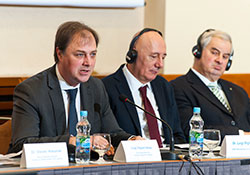Scientific community exchanges experience on polio eradication

WHO
The WHO Country Office in Ukraine and the Ministry of Health hosted a national conference on polio eradication on 16–17 March 2016 in Kyiv, Ukraine.
The conference engaged the scientific and academic community in Ukraine in response to the country's polio outbreak. It also served to share progress in the global eradication of polio and in routine immunization ahead of the global switch from trivalent to bivalent oral polio vaccine in April 2016.
In his introduction, the Deputy Minister of Health, Dr Ihor Perehinets, emphasized that Ukraine's scientific and academic communities, including the National Polio Laboratory, Sanitary Epidemiological Service and National Certification Committee, are important stakeholders in the technical aspects of the polio outbreak response.
Absence of cases not indicative of risk
The Ministry of Health of Ukraine has been leading the response with the support of WHO, the United Nations Children's Fund, Rotary International and other partners to regain the country's polio-free status since the outbreak was declared in August 2015. 3 rounds of supplementary immunization have taken place since the launch of the campaign in October 2015. The third and final round reached 83% of the target population.
Steve Wassilak, Medical Epidemiologist at the United States Centers for Disease Control and Prevention, emphasized that although it has been several months since children were paralyzed in Ukraine, the country must continue its active response. He noted that several of the circulating vaccine-derived polio outbreaks, like the one in Ukraine, have had large time gaps between cases, saying "Madagascar had 8 months between the first case and subsequent cases. Guinea had almost 11 months between its first identified case and subsequent cases."
Dr Manfred Green, Head of the Israeli National Certification Committee, shared Israel's experience in responding to a silent outbreak, where there were no polio infections but the oral polio vaccine was introduced in order to enhance the population's gut immunity and to stop the virus from circulating in the environment.
Ukraine preparing for outbreak response assessment
In April, an assessment team of international experts will arrive to measure the outbreak response in the country. This will be followed by a review by the European Regional Commission for the Certification of Poliomyelitis Eradication, which will examine the assessment team's findings and determine whether circulation of polio virus in Ukraine has been stopped and the outbreak is over.
"What we need to get from Ukraine to close this story is the absence of any poliovirus," said Dr Donato Greco, European Regional Certification Commission member and Polio Advisor for the European Centre for Disease Control. "In June we have to take the certificate for the European Region's polio free status and decide if it is still valid."
WHO is urging Ukraine to use March 2016 as an opportunity to close the gap in immunization and to retake its polio-free status.
Ukraine's polio outbreak
On 1 September 2015, Ukraine's Minister of Health announced that polio had been identified as the cause of paralysis in 2 children, aged 10 months and 4 years. The children live in Zakarpatska oblast in the south-western part of Ukraine. So far, no additional cases have been detected, but millions of under-immunized children in the country are at acute risk.
The Global Polio Eradication Initiative
Since its launch at the World Health Assembly in 1988, the Global Polio Eradication Initiative has reduced the global incidence of polio by more than 99% and the number of countries with endemic polio from 125 to 2. More than 10 million people are walking today who otherwise would have been paralyzed. Ukraine is a key country in the landscape of polio eradication, because its outbreak threatens the European Region's polio-free status. As long as polio exists in the world, it has the potential to infect vulnerable children.



